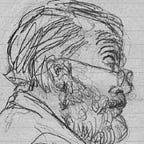Why Infrastructure?
Text of my intervention in the ‘Interrogating Infrastructure’ workshop organised by the King’s Digital Lab and the Department of Digital Humanities, King’s College London
My name is Andrew Prescott. I’m from the University of Glasgow and I am also the Theme Leader Fellow for the Arts and Humanities Research Council strategic theme of Digital Transformations. I should stress that I do not and cannot represent the AHRC. All views I will express here today are personal.
The term infrastructure derives from Cold War military planning. In my view, it is an outdated metaphor which is unhelpful for work undertaken in the digital humanities. The idea of infrastructure needs to be discarded and we need to completely rethink our view of the activities we currently designate as infrastructural.
The word infrastructure was coined by French railway engineers in the late nineteenth century and introduced into English in the 1950s. In its final communique in September 1951, the council which planned the establishment of NATO noted that agreement has been reached on the financing of an “infrastructure” (in inverted commas) program of airfields, communications, and certain installations for the support of forces (http://www.nato.int/docu/comm/49-95/c510920a.htm). This is one of the first uses of the word infrastructure in English. Winston Churchill mocked the word as a piece of meaningless military jargon, but it was quickly adopted for other purposes, for example by now discredited economists such as Rostow who investigated the pre-conditions for economic growth and argued that infrastructure was a vital component (Rankin 2009).
The problem with the word ‘infrastructure’ lies in its etymology, with the use of the Latin word ‘infra’, below. The term suggests that, while the infrastructure is essential, it is also subsidiary. This simple vertical model might be appropriate for railway bridges or aircraft hangars but it is not relevant to what we do in the humanities. An orchestra is not a piece of musical infrastructure; it is integral to the music. A dancer is not human infrastructure. Above all, libraries, archives, and museums are not infrastructure. The manuscripts, books and objects in these institutions are the heart of the humanities, the object of its study, not a supporting service for the humanities. The use of the term ‘research infrastructures’ for such institutions is a piece of verbal nonsense worthy of the scorn of Winston Churchill.
As the historian of technology Dirk Laak has emphasised, infrastructures are rarely wholly planned or imposed top down: ‘against the will of their creators — and also against the concepts of politicians — infrastructures seem to have a will of their own. They are not only pushed through from above but also demanded from below, conflicting interests influence their shape, and they are used and rearranged in reaction to actual needs’ (Laak 2004: 55–6). Not only are infrastructures messy, but they are often not in the vertical alignment implied by the term. The economist William Rankin has emphasised how, ‘even though an electric grid can be seen both as a network and as infrastructure, as a network it is defined by connections and pathways through which something circulates, while as infrastructure it is defined by its supportive relationship to other economic activities’ (Rankin 2009: 2). Is the vertical metaphor of infrastructure the best analogy for the horizontal structure of the internet?
Within digital humanities, the idea of infrastructure is particularly unhelpful because it encourages a prejudice that digital work is a supporting activity, subsidiary to research and teaching. The idea of infrastructure is used to justify the designation of librarians, archivists, computer developers and digital humanities specialists as ‘support’ services, at a safe arm’s length from the privileged and pampered core business of academic endeavour. If this is wrong-headed in the case of libraries, archives and museums, in digital humanities these infrastructural assumptions are dangerous, because they privilege verbal discourse and teaching, relegating the practice of humanities computing to the margins.
We will never achieve digital humanities unless we discard the metaphor of infrastructure and completely rethink the relationship of all the varied activities that make up our joint endeavour.
Laak, Dirk, 2004. Technological Infrastructure, Concepts and Consequences. Icon, 10: 53–64.
Rankin, William J., 2009. Infrastructure and the international governance of economic development, 1950–1965. In In Jean-François Auger, Jan Jaap Bouma and Rolf Künneke,
eds., Internationalization of Infrastructures: Proceedings of the 12th Annual International Conference on the Economics of Infrastructures. Delft: Delft University of Technology.
